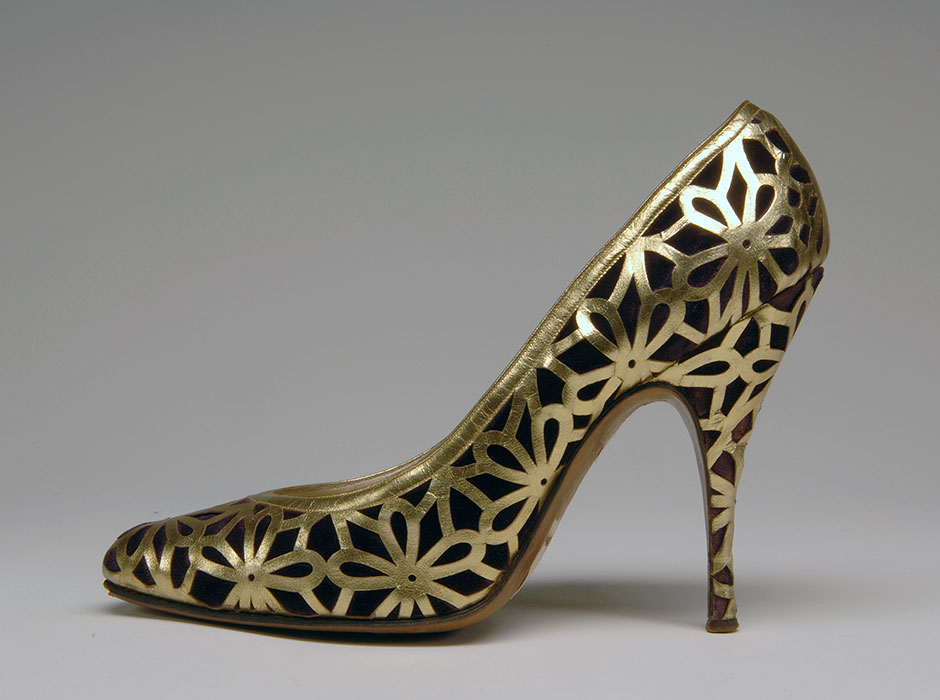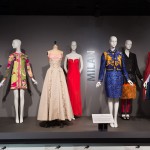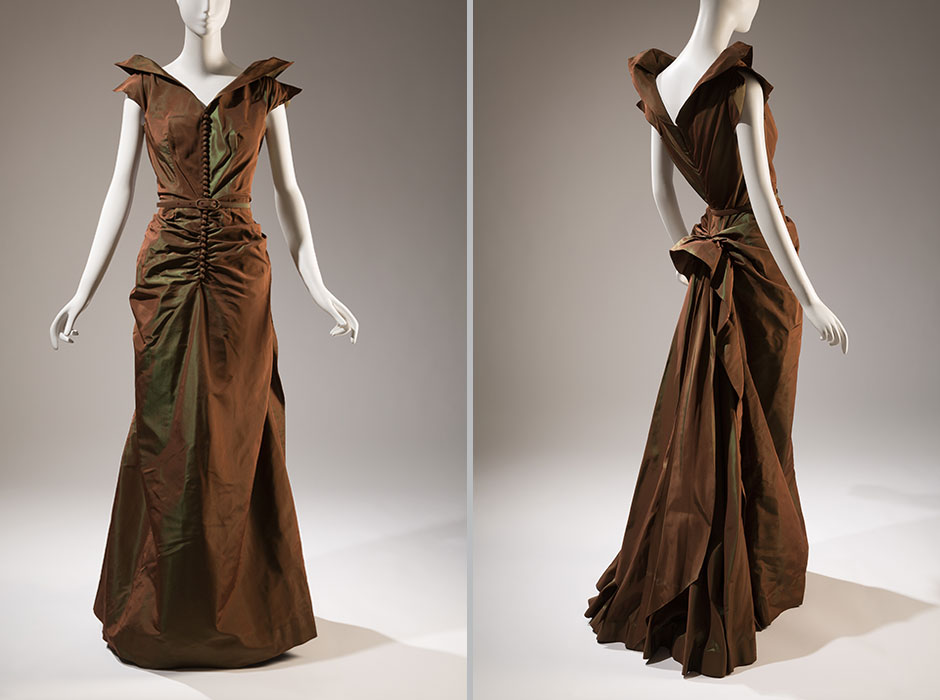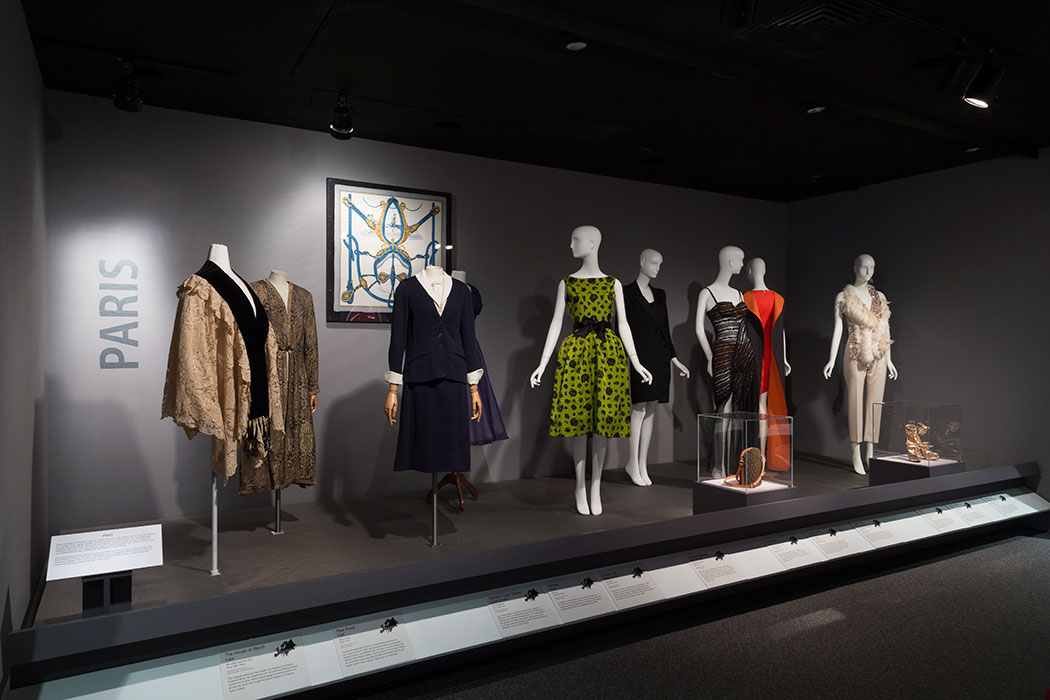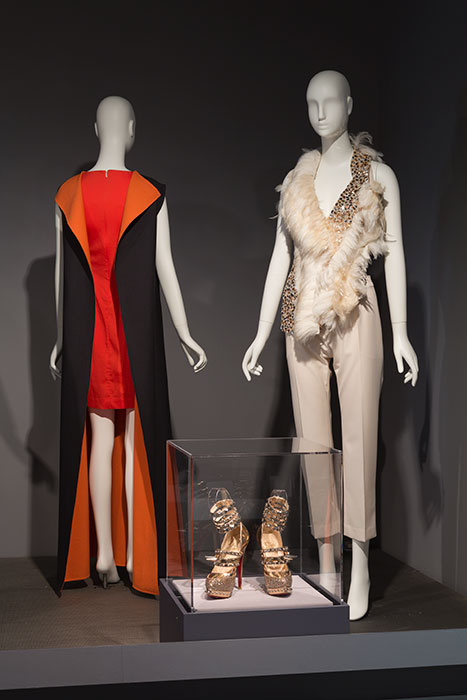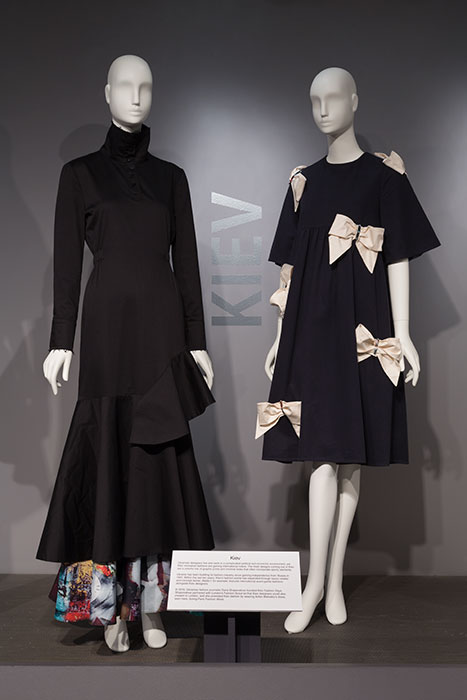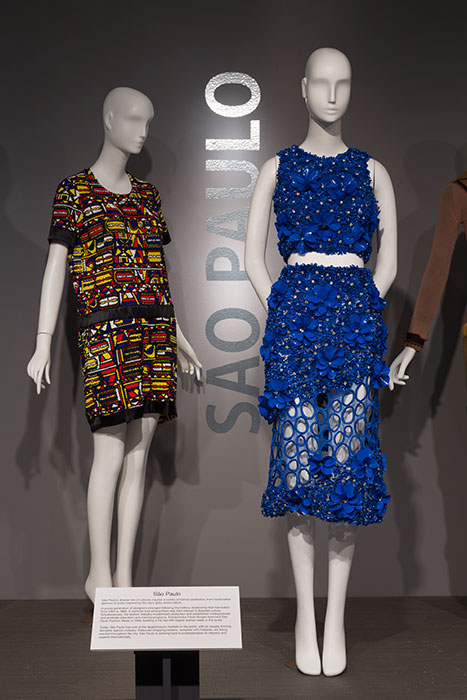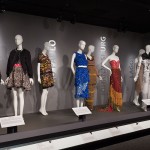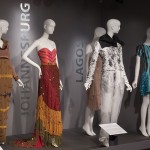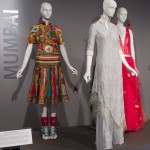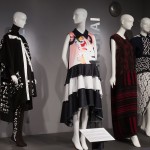London
London
London captured international attention during the 1960s and 1970s with vibrant, youth-culture fashions by designers such as Mary Quant. Innovative and experimental brands dominated, but tended to be small, unstable, and decentralized. The British Fashion Council, founded in 1983, helped professionalize the industry, drawing the attention of international press and buyers to talented designers, such as Alexander McQueen and John Galliano.
London’s highly-acclaimed fashion colleges, such as Central St. Martins and the London College of Fashion, attract students from all over the world, many of whom stay on in order to establish their brands. In fall 2015, over one-third of London Fashion Week’s designers originated outside the United Kingdom, bringing diversity and fresh perspectives to the city.
Today, the British Fashion Council maintains London’s commitment to avant-garde and international talent. Its 2015 International Fashion Showcase, featured more than 400 designers from over 50 countries.
-
Image InfoClose
Installation view
-
Image InfoClose
Installation view
Mary Quant Dress (Left)
Mary Quant’s designs, exemplified by this fun, simple mini-dress, are inseparable from 1960s London mod style. One of London’s most successful independent designers at the time, Quant sold her fashions in her Bazaar boutiques, and in 1963 began mass-manufacturing and exporting to the United States.
Linen, 1963, London, 92.160.11, gift of Chippy Irvine
Vivienne Westwood Ensemble (Center)
Vivienne Westwood’s historically-inspired, subversive designs, such as this tartan hunting ensemble, helped establish London’s innovative character. In 1988, Westwood moved her manufacturing to Milan, allowing her to expand and meet international demand. New York buyers from Bloomingale’s noted, “The stuff arrives on time—and sells as soon as it gets there.”
Wool and cotton, fall/winter 1988, London, P88.45.1, museum purchase
-
Image InfoClose
John Galliano dress and slip (Left)
London-trained John Galliano decamped to Paris in 1989, where he grew to international stature directing design at Givenchy, Christian Dior, and now, Maison Martin Margiela. However, as author Andrew Tucker states, “Galliano’s approach is very much that of a British designer . . . he absorbs wildly diverging historical and cultural elements to invent new hybridizations of the contemporary.”
Silk, viscose, polyester, 1990s, Paris, 2014.48.2, museum purchase
Alexander McQueen dress and corset (Right)
Alexander McQueen’s iconoclastic style is synonymous with London fashion, although he presented many collections in Paris. He trained on Saville Row before attending Central Saint Martins, and even as a young designer in the 1990s, his provocative shows drew press to London. McQueen stated, “London’s where I was brought up. It’s where my heart is and where I get inspiration.”
Silk and leather, spring/summer 2009, London, 2014.38.1, museum purchase
-
Image InfoClose
Gareth Pugh dress
When Gareth Pugh showed this futuristic dress in fall 2007, fashion editor Sarah Mower declared him “largely responsible for bringing back the excitement in this city.” Like much of London’s innovative, distinctive talent, he was soon lured to Paris. But upon the occasion of his brand’s 10th anniversary in March 2015, Pugh returned home to show in London once again.
Wool and patent leather, fall 2007, London, 2010.87.1, museum purchase
-
Image InfoClose
Christopher Kane dress
This layered organza dress is from Christopher Kane’s highly-publicized, fall 2014 collection. It shows Kane’s extraordinary ability to balance skillful construction with unconventional, yet wearable, silhouettes. Poised to become a major international label, Christopher Kane attracted investment from Kering luxury group in 2013.
Silk, fall 2014, London, 2015.15.1, museum purchase
Milan
Milan
Milan is known for luxury ready-to-wear and innovative fabrics, such as those used in the Prada ensemble on view in the exhibition. The Italian government recognizes fashion as a vital industry and recently invested 40 million euros in its expansion. However, Milan has not always been at the center of the Italian fashion scene.
During the mid-20th century, Florence and Rome were the fashion capitals of Italy. The first fashion show to bring Italian designers together in one place was held in Florence in 1951. However, couturiers eventually began to gravitate back toward Rome. That created a rivalry between Italy’s two fashion capitals, which allowed Milan to rise during the 1970s.
Milan may not have had the glamorous cachet of Florence and Rome, but its large manufacturing industry and international airport made it an ideal location. By 1975, the National Chamber of Italian Fashion had begun to hold its fashion week there.
-
Image InfoClose
Installation view
-
Image InfoClose
Emilio Pucci Dress
Emilio Pucci put Italian fashion on the map when he presented at the Sala Bianca, Florence’s first fashion show in 1951. The relaxed style of his silk jersey designs differentiated Florence boutique fashion from Rome’s couture industry. By 1967, the popularity of his resort wear had reached such heights that some called it “Puccimania.”
Silk jersey, 1964-1965, Florence, 2002.91.1, gift of Miriam F. Jacobs
Gucci man’s dopp kit (Shelf)
Guccio Gucci established his company in 1921 and began producing luxury leather bags for horsemen in Florence. This extravagant pigskin dopp kit was designed to appeal to the fashionable man of the early 1960s “jet set.” Its green and red stripe is a Gucci signature, inspired by the traditional British canvas girth strap that holds a horse’s saddle in place.
Pigskin and canvas, 1960s, Florence, 90.183.31, gift of Mrs. Vladimir Horowitz
-
Image InfoClose
Salvatore Ferragamo Shoe
After starting a shoe design company in Hollywood, Salvatore Ferragamo moved back to Italy in 1927 to set up his business in Florence. He created custom, handmade shoes for visiting stars, such as Greta Garbo, Rita Hayworth, and Marilyn Monroe. His extraordinary craftsmanship helped to solidify Florence’s reputation as the center of international luxury accessories.
Velvet and leather, 1959, Florence, 71.213.55, gift of Sally Cary Iselin
-
Image InfoClose
Emilio Pucci Bag
Cotton velveteen and metal, circa 1969, Florence, 91.233.2, gift of Yvonne Dunleavy
-
Image InfoClose
Sorelle Fontana evening gown (Left)
One of the first Roman couture houses, Sorelle Fontana was founded by three sisters in 1944. Their international reputation extended to Hollywood, as they dressed stars such as Ava Gardner, Elizabeth Taylor, and Audrey Hepburn.
Silk taffeta, 1950s, Rome, 69.211.19, gift of Mrs. Robert Brown
Valentino Couture Evening gown (Right)
In 1959, Valentino opened his atelier in Rome, continuing the Italian couture tradition, known as alta moda. Valentino became the first Italian designer to be featured on the cover of French Vogue, in July 1962.
Silk jersey, circa 1973, Rome, 2011.45.1, gift of Mina Atabai
-
Image InfoClose
Prada Ensemble
In 1978, Muccia Prada revived her grandfather’s 65-year-old Milanese leather goods company and turned it into a globally recognized brand. Now one of Milan’s most admired fashion designers, Prada carries on the tradition of creating luxury Italian textiles, often in unusual combinations that are distinctly her own.
Black wool, plastic fringe, orange fleece, fall 2007, Milan, 2007.20.1, gift of Prada
-
Image InfoClose
Gianni Versace suit (Left)
Gianni Versace was one of the most famous designers of the late 20th century. As early as 1978, his glamorous and sexy fashions drew international press, elevating Milan as a capital of luxury ready-to-wear.
Wool and silk, circa 1992, Milan, 98.20.6, gift of Judith Corrente & Willem Kooyker
Prada ensemble (Right)
Black wool, plastic fringe, orange fleece, fall 2007, Milan, 2007.20.1, gift of Prada
-
Image InfoClose
Stella Jean
Stella Jean takes a fresh approach to Milanese fashion. Drawing inspiration from her dual Italian and Haitian heritage, she combines vibrant handwoven fabrics from Burkina Faso in West Africa with the Italian tradition of fine tailoring. Jean explains, “The two cultures never negotiate their own membership, instead mixing in response to the needs of the times.”
Cotton, wool, nylon, fall 2015, Milan, 2015.4.2, gift of Stella Jean
New York
New York
Designers in New York City traditionally copied Paris fashions, but during the Nazi Occupation of Paris, they were forced to create independently. After World War Two, Paris regained supremacy, but New York’s garment district began to shift from mass manufacturing to creative design.
Publicist Eleanor Lambert played a pivotal role in organizing the first Press Week (later renamed Fashion Week) in 1943. She established the Council of Fashion Designers of America (CFDA) in 1962 to “help strengthen the influence and success of American designers in the global economy.” During the 1970s, New York again challenged Paris and become a prominent fashion city in its own right. New York fashion is known for streamlined, functional sportswear that can transition from day to evening. The city is home to Vogue, Harper’s Bazaar, and Women’s Wear Daily, as well as the Fashion Institute of Technology and Parsons, two of the world’s top fashion schools. New York Fashion Week hosts over 350 shows, featuring more than 20 international designers.
-
Image InfoClose
Installation view
-
Image InfoClose
Nettie Rosenstein Evening dress
Nettie Rosenstein was an immigrant from Austria who began sewing at age eleven. During her trips to Paris, Rosenstein was inspired by the French couture traditions to create her sophisticated designs. She was an astute businesswoman who developed a robust wholesale company that helped to elevate the reputation of New York’s garment district.
Silk taffeta, circa 1938, New York, 76.32.1, gift of Gloria Carr de Veynac
-
Image InfoClose
Claire McCardell Dress
Described by the press as “America’s most American designer,” Claire McCardell made designs that could transition from the beach to dinner. Her affordable, yet elegant creations transformed the reputation of 7th Avenue manufacturers.
Cotton, 1954, New York, 76.33.34, gift of Sally Kirkland
-
Image InfoClose
Halston evening dress (Right)
Halston was America’s first celebrity designer. His mastery of garment construction is evident in this simple dress created from one length of silk chiffon that spirals around the body on the bias. Halston put New York fashion on the map as one of five American designers to show at the 1973 “Battle of Versailles” fashion show.
Silk chiffon, 1976, New York, 2014.15.9, gift of Christina Noble
-
Image InfoClose
Bonnie Cashin Shirt
Tweed and metal, 1961, New York, , 2009.34.1, gift of Adassa WhitmanBonnie Cashin Skirt
Wool jersey, leather, metal, fall 1961, New York, 79.222.3, gift of Phillip SillsBonnie Cashin was known for incorporating industrial hardware, such as brass toggles and metal snaps, into her designs to give them a functional, yet chic quality. Many of her designs have become American classics.
-
Image InfoClose
Ralph Lauren evening ensemble (Left)
Ralph Lauren is a truly global designer. His brand is recognized on every continent, and his designs have been described by biographer Michael Gross as the “Americanization of international fashion.”
Lurex®, wool, silk satin, circa 1980, New York, 2003.30.2, gift of Millie Graves
Donna Karan ensemble (Center Left)
A Donna Karan signature, the knot on this skirt allows the fabric to fall in a flattering drape around the hips. Karan’s 1980s separates gave busy career women the ability to create a seemingly effortless, yet professional, look. She uses New York City as a backdrop in her DKNY ad campaigns, inextricably identifying her brand with the city.
Wool jersey, 1984, New York, 96.53.1, gift of Mary Joan Glynn
-
Image InfoClose
Proenza Schouler evening dress (Left)
Jack McCollough and Lazaro Hernandez, the design duo behind the brand Proenza Schouler, are among New York’s fashion stars. They incorporate innovative, cutting-edge textiles into their youthful designs. With stores in New York, Seoul, Bangkok, Singapore, and Kowloon, their brand continues to expand internationally.
Sequins, spring 2005, New York, 2005.31.1, museum purchase
Alexander Wang dress (Right)
Alexander Wang takes an innovative approach to incorporating elements of activewear into his designs. Inspired by sneaker culture, he transformed the lines and perforated mesh textiles used in Nike’s flyknit sneakers into this sportswear dress. As head designer for both Balenciaga and his sportier, eponymous New York brand, Wang has become a familiar name in American and French fashion.
Synthetic blend mesh knit and cotton, spring 2015, New York, 2015.17.1, gift of Alexander Wang
Paris
Paris
Paris has been inextricably linked to fashion since the 18th century. By the mid-19th century, the modern Paris fashion system had evolved, led by couturiers such as the Englishman Charles Frederick Worth. During the 20th century, couture houses such as Chanel and Christian Dior drew customers from all over the world. Designers from other countries, such as Cristóbal Balenciaga, established businesses in Paris as well.
As couture became less relevant during the 1960s and 1970s, prêt-à-porter reinvigorated Paris’ fashion-forward reputation. Designers such as Azzedine Alaïa created exciting and innovative fashion. Paris remains the world’s leading fashion capital, supporting world-renowned brands and fostering new design talent.
-
Image InfoClose
Installation view
-
Image InfoClose
The House of Worth Cape
This exquisite velvet and lace mantle was designed by Charles Frederick Worth, the Englishman who became the leading Parisian couturier of his time. Worth’s lavish designs attracted clients from all over the world, who sought the mythic elegance of Parisian haute couture.
Silk velvet and linen lace, circa 1890, Paris, 69.160.9, gift of the Estate of Elizabeth Arden
-
Image InfoClose
Paul Poiret coat (2nd from Left)
Paul Poiret worked at the House of Worth before launching his own couture house in 1903. His flowing silhouettes and exotically-inspired themes, exemplified in this luminous, brocade evening coat, revolutionized Parisian fashion. Poiret ushered in the modern design era, promoting fashionable lifestyles that incorporated clothing, art, theater, dance, interior design, fragrances, and cosmetics.
Silk brocade, 1925, Paris, P76.1.2, museum purchase
Gabrielle “Coco” Chanel jacket and skirt (Center left)
Coco Chanel helped to modernize Paris fashion during the 1920s and 1930s by recreating the image of the chic Parisienne. Eschewing the elaborately decorated styles of her predecessors, she designed luxuriously casual, sporty clothing, such as this pared-down jersey suit. Chanel’s couture house has endured and evolved as a symbol of Paris fashion.
Wool double knit, circa 1935, Paris, 76.53.1, gift of Louise Dahl-Wolfe
-
Image InfoClose
Christian Dior Bodice and skirt
Christian Dior’s “New Look” famously transformed fashion in 1947, introducing a romantic, feminine look. Dior quickly became the world’s most famous fashion designer, leading the rebuilding of Paris’ fashion export industry. By 1949, Christian Dior accounted for five percent of the entire country’s export profits.
Silk chiffon, circa 1950, Paris, gift of Mrs. Tilly Friedman, 85.172.3
-
Image InfoClose
Cristóbal Balenciaga Dress and sash
Balenciaga created bold silhouettes that retain elegant, clean lines. This chartreuse cocktail dress shows his mastery of volume and proportion. Originally from Spain, Balenciaga is one of many foreign-born designers who helped define Parisian fashion. He elevated couture as an art form, and Dior described him as “the master of us all.”
Silk faille and silk satin, 1959, Paris, 75.170.1, gift of Kay Kerr Uebel
-
Image InfoClose
Installation view
-
Image InfoClose
Yves Saint Laurent dress and top (Left)
Yves Saint Laurent began his career working at Christian Dior. After opening his own couture boutique, he went on to dominate the Paris fashion scene from the 1960s until the 1980s. Saint Laurent updated haute couture for contemporary culture and helped bring relevancy and excitement back to Parisian couture, while simultaneously setting international ready-to-wear trends.
Wool and silk satin, circa 1988, Paris, 95.85.9, gift of the Estate of Helen Hotze Haas
Azzedine Alaïa dress and panties (Right)
Alaïa’s body-conscious, lingerie-style lace dress and coordinating panties reveal his love of the female form. The Tunisian-born Alaïa led the sexy, powerful Parisian fashion aesthetic of the 1980s and early 1990s. He is a highly-skilled constructionist who incorporates intricate piecing into fashions that emphasize and flatter the body.
Cotton blend lace and silk crepe chiffon, spring 1993, Paris, 2013.25.2, gift of Veronica Del Gatto
-
Image InfoClose
Christian Louboutin Shoes
These wickedly glamorous, metallic high heels are easily recognizable as the work of Paris native Christian Louboutin. Their sexy, feminine style and prominent red soles are signature elements, and the spikes and studs reveal Louboutin’s interest in subversive fashions. Louboutin established his Paris-based brand and boutique in 1992.
Leather, metal, rhinestones, fall 2008, Paris, 2009.5.1, museum purchase
-
Image InfoClose
Bouchra Jarrar harness and trousers (Left)
Bouchra Jarrar’s modern designs have invigorated Parisian haute couture. Although she has been called a rising star by the press, Jarrar is a veteran of Paris fashion. She led Balenciaga’s studio and atelier teams for ten years before founding her house in 2010. In 2013, the Chambre syndicale de la haute couture officially invited her to show during couture week.
Viscose, rooster feathers, crystal, fall 2013, Paris, 2015.20.1, gift of Bouchra Jarrar
Yang Li dress (Right)
Born in Beijing, raised in Australia, and educated in London, Yang Li launched his label in Paris in 2011 and began presenting runway shows at Paris fashion week in 2013. Li draws inspiration from his varied experiences and a wide range of sources. The bonded fabric in this dress, for example, refers to the multi-layered construction of skateboards.
Bonded wool blend and stretch cotton, spring/summer 2012, Paris, 2015.36.1, museum purchase
Tokyo
Tokyo
Tokyo is famous for cutting-edge fashion. While some designers modernize traditional Japanese aesthetics, others draw on Tokyo’s pop culture and radical streetwear, or they reinvent classic western clothing, glorifying precision and detail.
Japan began to westernize during the late 19th century. By the 1950s, most residents of Tokyo were wearing western dress. As Tokyo’s economy prospered during the 1980s, international fashion brands, such as Louis Vuitton, became popular. Simultaneously, youth-centered style tribes were cultivating extreme streetwear fashions, creating unique Tokyo looks.
During the early 1980s, three Tokyo designers—Issey Miyake, Yohji Yamamoto, and Rei Kawakubo—sparked the “Japanese fashion revolution” in Paris by introducing subversive, yet ultimately influential styles that challenged conventional fashion. Tokyo’s designers have persistently cultivated individualistic aesthetics, and brands like Sacai continue to show in Paris to international acclaim.
-
Image InfoClose
Installation view
-
Image InfoClose
Issey Miyake Permanente ensemble (Left)
This early ensemble reveals Issey Miyake’s philosophical explorations of wrapped and tied cloth. Note the loose silhouette made up of rectangular fabric pieces, as well as Miyake’s use of traditional Japanese resist-dye textile techniques. A pioneer of fine-art conceptualism in fashion, Miyake introduced his Tokyo-based brand in Paris in 1973.
Resist-dyed cotton, circa 1975, Tokyo, 93.76.16, gift of Jun Kanai
Comme des Garçons dress (Right)
Rei Kawakubo of Comme des Garçons first presented her designs in Tokyo, but attracted international attention in 1981 when she first showed in Paris. At the time, styles such as this asymmetrically-draped knit dress were criticized by western journalists as drab and ugly, but now Kawakubo is respected worldwide as a true innovator and artist.
Cotton jersey, 1983-1984, Tokyo, 2008.77.4, gift of Janet Cooper
-
Image InfoClose
Yohji Yamamoto Corset
This wooden corset demonstrates Yohji Yamamoto’s penchant for deconstructing and reworking historical western dress. He is a skillful craftsman who likes to experiment with unconventional materials. An alumnus of Tokyo’s prestigious Bunka Fashion College, Yamamoto established his label in Tokyo in 1972. He began presenting in Paris in 1981 and continues to create avant-garde designs today.
Wood, wool, metal, fall 1991, Tokyo, 2010.1.2, anonymous gift
-
Image InfoClose
Sacai jacket and skirt (Left)
Fashion editor Robin Givhan says that Chitose Abe is “part of a grand lineage of Japan-born designers whose urbane, non-Western ideas wield global influence.” Abe, the designer behind Sacai, creates intricate hybridizations and reinventions of classic garments. Based in Tokyo, Sacai was propelled to international standing when Abe began presenting runway shows at Paris Fashion Week in 2011.
Cotton twill and silk organza, spring 2015, Tokyo, 2015.37.1, museum purchase
matohu ensemble (Right)
Every season during Tokyo fashion week, Hiroyuki Horihata and Makiko Sekiguchi of matohu present different iterations of their minimalist, kimono-inspired ensembles. This contemporary take on Japanese tradition features a batik-dyed (rōketsu-zome) outer layer created by textile artist Yukiko Nakai.
Silk, wool, kidskin, spring/summer 2015, Tokyo, 2015.42.1, gift of matohu
Moscow / St. Petersburg
Moscow / St. Petersburg
Designers from Moscow and St. Petersburg are constructing a multi-faceted Russian fashion identity. The end of the Soviet era in 1991 allowed luxury brands to enter into Russia. Vogue Russia was launched in 1999, and the creation of Fashion Week Russia in 2000 helped build a fashion system in Moscow.
Nine years later, St. Petersburg introduced the alternative Aurora Fashion Week, with an emphasis on experimental fashion. While both fashion cities continue to grow, they lack government support and a proper manufacturing infrastructure, which makes production costly. Last year, the Russian Fashion Council was founded to support the industry and build its manufacturing base. New York-based Depesha magazine promotes Russian fashion internationally.
-
Image InfoClose
Installation view
-
Image InfoClose
Pirosmani Ensemble
Jenya Malygina’s dark, romantic designs for Pirosmani have become mainstays of fashion in both Moscow and St. Petersburg since 1999. The complex deconstruction of this ensemble is based on Malygina’s concept of the impulse of immense beauty. She said, “I break myself, rip things into tiny pieces to take out the spark [of beauty] hiding inside.”
Denim, nylon net, polyester crêpe, Stendhal Syndrome collection, fall 2014, Moscow, 2015.25.1, gift of Jenya Malygina
-
Image InfoClose
Homo Consommatus Dresses and shoes
Alexey Sorokin graduated from the Saint Petersburg State Academy of Art and Design in 2008. Two years later, he established Homo Consommatus, the label he uses to explore issues of consumerism. Sorokin debuted these identical dresses during a multi-media presentation at New York Fashion Week, describing them as “twins emerging as the ideal creature” after all the earth’s natural resources have been used up.
Cotton, silk, lame, batiste, python, NUKLEOTRANSFER collection, spring 2013, St. Petersburg, 2014.14.1 and 2014.14.2, gift of HOMO CONSOMMATUS
Stockholm / Copenhagen
Stockholm / Copenhagen
Stockholm and Copenhagen compete as fashion capitals in the Nordic region, yet both are recognized as cities with a classic, but edgy, style. Designers such as Stockholm’s Ann-Sofie Back re-conceptualize basic garments into refined, yet practical fashions for urban life. Clean, strong silhouettes characterize what international fashion bloggers term “Scandi-cool.”
The apparel manufacturing industries of the two cities date to the mid-20th century. When manufacturing moved offshore during the 1980s and 1990s, focus shifted to fashion design, distribution, marketing, and retailing, while sustainability became a priority.
Both cities’ fashion industries are dominated by large brands—H&M in Stockholm, for example—yet smaller designer labels with strong domestic followings, such as Henrik Vibskov in Copenhagen, have an increasing impact on international fashion. Style.com acknowledged the cities’ importance by featuring runway images from their fall 2015 fashion weeks.
-
Image InfoClose
BACK Ensemble
This blazer-and-skirt ensemble by Ann-Sofie Back, layered over sheer trousers and a denim skirt, illustrates her intelligent, androgynous style. She uses her BACK, currently her sole label, to explore past fashion concepts. It is carried by nearly 100 retailers worldwide. She is also the creative director of the Swedish brand, Cheap Monday, extending her international influence.
Wool, polyester, elastic, cotton, metal, spring 2015, Stockholm, 2015.3.1, gift of Ann-Sofie Back
-
Image InfoClose
BACK ensemble (Left)
Wool, polyester, elastic, cotton, metal, spring 2015, Stockholm, 2015.3.1, gift of Ann-Sofie Back
Henrik Vibskov dress (Right)
This tufted dress exemplifies Henrik Vibskov’s interest in inventive materials. Designboom magazine describes Vibskov as a designer, musician, and artist who is “the creator of eccentric universes that accompany each of his wearable collections.” Vibskov’s bold creativity extends to his performance-art fashion shows and multi-brand boutiques in Copenhagen, Oslo, and New York.
Cotton blend, cotton fringe, wool embroidery, fall 2015, Copenhagen, 2015.18.1, gift of Henrik Vibskov
Berlin / Istanbul / Kiev
Berlin
Berlin is a creative epicenter with an energetic art, film, music, and theater scene. An emerging generation of young designers is changing the stereotype of commercial, functional German fashion and bringing to the city a fresh range of styles, from edgy street wear to avant-garde creations. This ensemble by Marina Hoermanseder is one example.
Since the fall of the Berlin Wall in 1989, the government has worked to rebuild the economy and burnish the reputation of the city. Its 2006 “Create Berlin” campaign promoted fashion as an important creative industry. A year later, IMG and Mercedes-Benz sponsored the first Fashion Week Berlin.
Despite quality manufacturing and innovative design, Berlin’s fashion industry still struggles to gain traction. The absence of a governing fashion organization has resulted in a lack of cohesion. However, recent initiatives, such as the Berliner Salon at Fashion Week and the “Start Your Own Business” award, have been launched to support emerging designers.
Kiev
Ukrainian designers live and work in a complicated political and economic environment, yet their innovative fashions are gaining international notice. The fresh designs coming out of Kiev are a colorful mix of graphic prints and minimal looks that often incorporate sporty elements.
Ukraine has been building its fashion industry since gaining independence from Russia in 1991. Within the last ten years, Kiev’s fashion scene has expanded through luxury retailer and concept stores. Atelier1, for example, features international avant-garde fashions alongside Kiev designers.
In 2010, Ukrainian fashion journalist Daria Shapovalova founded Kiev Fashion Days. Shapovalova partnered with London’s Fashion Scout so that Kiev designers could also present in London, and she promoted Kiev fashion by wearing Anton Belinskiy’s dress, on view in the exhibition, during Paris Fashion Week.
-
Image InfoClose
Marina Hoermanseder dress and sweater (Left)
In just four collections, Marina Hoermanseder has begun leading a new design aesthetic for Berlin. She said, “I always have this tightrope to walk between the fetish, the avant-garde, and fashion.” After attending ESMOD in Berlin, she interned under Alexander McQueen, and received the Start Your Fashion Business award
from the Berlin Senate in 2014.Leather, fiberglass, mohair, fall 2015, Berlin, 2015.28.1, gift of Marina Hoermanseder
Kilian Kerner ensemble (Right)
The Berlin music scene informs the work of designer Kilian Kerner, whose runway shows include live musical performances. Now in his 20th collection, Kerner is considered one of Berlin’s most successful designers. For this dress, he used photographs from a ten-day getaway to Dublin, Ireland, to create an abstract print.
Cotton and synthetic, A Touch of Irish Skin collection, fall 2015, Berlin, 2015.29.1, gift of Kilian Kerner
-
Image InfoClose
Anton Belinskiy Dress (Left)
Anton Belinskiy integrated the work of Kiev graffiti artist Vova Vorotniov into this dress. A politically-motivated designer, Belinskiy brought awareness of political unrest in Ukraine to the fashion world after staging a photoshoot in the middle of protests in 2013.
Cotton and synthetic, fall 2015, Kiev, 2015.17.1, gift of Anton Belinskiy
Anna K Dress (Right)
The oversized bows and Swarovski crystals on this dress provided a whimsical break from the politically-charged fashions that dominated Kiev’s runways in 2014. Anna K is a 19-year-old model-turned-designer who, in only three years, has expanded internationally to sell in over 40 countries. The “K” in her name derives from the character Anna Karenina in Leo Tolstoy’s novel.
Cotton corduroy, cotton sateen, Swarovski crystals, fall 2015, Kiev, 2015.14.1, gift of Anna K.
-
Image InfoClose
Istanbul
In 2010, the European Union designated Istanbul a European Capital of Culture, an honor bestowed annually in order to “foster the contribution of culture to the development of cities.” Istanbul’s historic monuments, bustling Grand Bazaar, and burgeoning contemporary art scene provide a wealth of inspiration for its fashion designers such as Arzu Kaprol, who creates bold graphic pieces with superb workmanship.
Having built a robust manufacturing industry with exports that reached 19 billion dollars a year, the government and the textile industry began expanding into fashion design during the mid-2000s. In 2007, the Istanbul Fashion Academy was founded in partnership with the London College of Fashion. Designer Bahar Korcan played fundamental roles establishing both Istanbul Fashion Week in 2009 and Turkey’s Fashion Designers Association. London’s Center for Fashion Enterprises worked with the Istanbul Fashion Academy in 2013 to develop a business program to mentor emerging designers. There are plans for further collaboration in the future.
-
Image InfoClose
Zeynep Tosun Dress and harness (Left)
Style.com called Zeynep Tosun “one of the most talented and beloved figures in modern Turkish fashion.” Tosun studied with Milanese designer Alberta Ferretti, and the craftsmanship she developed under Feretti’s tutelage is evident in her collections.
Synthetic net, synthetic crepe and lace, faux patent leather, fall 2015, Istanbul, 2015.40.1, gift of Zeynep Tosun
Arzu Kaprol Jacket and dress (Right)
Arzu Kaprol has significantly contributed to Istanbul’s fashion industry by opening nine stores in Turkey since starting her company in 1998. Her business has expanded internationally, and she designs both ready-to-wear and couture collections, which are presented in Istanbul and Paris. In this boldly printed dress and quilted jacket, Kaprol combines fine craftsmanship with a sporty touch.
Synthetic knit, nylon, fall 2014, Istanbul, 2015.31.2, gift of Arzu Kaprol
Antwerp
Antwerp
In 1981, the Belgian government and the Institute for Belgian Textiles and Fashion created a five-year plan to restructure the country’s textile industry. Under the direction of Madame Prijot at the Royal Academy, a group of new designers emerged. Known as the Antwerp 6, they included Walter Van Bierendonck, Dries Van Noten, and Ann Demeulemeester, all of whom have work on view in this exhibition (the other three designers were Dirk Van Saene, Dirk Bikkembergs, and Marina Yee). In 1986, the Antwerp 6 captured the attention of the international press at London’s British Designer Show and put Antwerp on the fashion map.
Belgian designers are known for their conceptual approaches to fashion. Throughout the 1990s, the press was captivated by the Belgian presentations in Paris—especially those by Maison Martin Margiela. Although Antwerp does not host a fashion week, the city continues to produce talented designers who go on to work for some of the world’s largest fashion houses.
-
Image InfoClose
Installation view
-
Image InfoClose
Maison Martin Margiela Jacket
The Brevete S.G.D.G marking on this jacket refers to the French patent stamped on Stockmade couture dress forms. Maison Martin Margiela challenged the notion of what constitutes a garment by meticulously constructing this semi-couture piece to appear identical to a dress form. When Belgian-born Margiela started his company in Paris in 1988, he sparked global recognition of Antwerp as an avant-garde design hub.
Linen, spring 1997, Antwerp, 2009.91.1, museum purchase
-
Image InfoClose
Walter Van Beirendonck Ensemble
Walter Van Beirendonck, one of the celebrated designers of the Antwerp 6, was inspired by the Rapa Nui tribe of Easter Island to create this ensemble. He playfully accessorized it with a collar embellished with shells, beading, and embroidery. As head of the fashion department at the Royal Academy in Antwerp, Van Beirendonck is now training new generations of designers.
Raffia and cotton satin, Relics of the Future collection, spring 2006, Antwerp, 2007.54.1, gift of Walter Van Beirendonck
-
Image InfoClose
Ann Demeulemeester (Sébastien Meunier) ensemble (Center)
Ann Demeulemeester began presenting her collections in Paris in 1987. The delicate details of her black and white, deconstructed suits set her designs apart from those of the other members of the Antwerp 6. After retiring from her eponymous label, Sébastien Meunier took over as creative director in 2014 and designed this ensemble in the signature style of the brand.
Silk chiffon, silk thread, silk knit, spring 2015, Antwerp, 2015.46.1, gift of Ann Demeulemeester
-
Image InfoClose
Dries Van Noten ensemble (Left)
Dries Van Noten is known for his extraordinary ability to develop unique prints by layering disparate patterns and textures. Over the past 28 years, Van Noten has commissioned high quality Indian embroidery from a family-owned business in Calcutta. His colorful and ethnically inspired collections separate his work from the deconstructed and avant-garde designs of his Antwerp peers.
Silk, spring 2008, Antwerp, 2010.97.65, gift of Dries Van Noten Archives
A.F. Vandevorst ensemble (Right)
An Vandevorst and Filip Arickx, the duo behind A.F. Vandevorst, are part of the second generation of Antwerp designers. This ensemble was inspired by their trip to Peru, but they have said that “in our Belgian way, we took out all the color.”
Wool, wool aluminum, suede, fall 2015, Antwerp, 2015.33.1, gift of A.F. Vandevorst
Mexico City / São Paulo
Mexico City
Mexico City is experiencing a cultural renaissance. New architecture, restaurants, and contemporary art museums proliferate, but the city’s fashion scene is still in its formative stages. However, the tension in Mexican fashion between tradition and modernity inspires contemporary designers like Richard Seco to honor their cultural heritage by infusing their work with indigenous craftsmanship.
Since the 1980s, Mexico has increasingly opened its borders. The signing of the North American Free Trade Agreement in 1994 facilitated increased global commerce, and undergraduate fashion programs established during that decade have led to a surge of new designers. The introduction of Fashion Week Mexico in 2003 was a benchmark for the city’s growing industry. Set to open this year is the National Center for Innovation and Fashion.
São Paulo
São Paulo’s diverse mix of cultures inspires a variety of fashion aesthetics, from handcrafted glamour to looks inspired by the city’s gritty street culture.
A young generation of designers emerged following the military dictatorship that had lasted from 1964 to 1985. A common trait among them was their interest in Brazilian culture. Simultaneously, the fashion industry modernized production and established undergraduate and graduate education and training programs. Entrepreneur Paulo Borges launched São Paulo Fashion Week in 1996, building it into the fifth largest fashion week in the world.
Today, São Paulo has one of the largest luxury markets in the world, with an equally thriving domestic fashion industry. Elaborate shopping centers, complete with helipads, are being erected throughout the city. São Paulo is working hard to professionalize its industry and expand internationally.
-
Image InfoClose
Installation view
-
Image InfoClose
Carla Fernandez Suit
The hand-cut, purple suede appliqué on this suit was based on intricate Aztec patterning from a Mexican cowboy (charro) costume. Carla Fernandez melded symbols of the Mexican Revolution—such as an ammunition belt—with fine tailoring to give this suit a modern look. Fernandez collaborates with indigenous Mexican tribes in her Taller Flora workshop and incorporates their artistry into her designs.
Wool and purple suede, fall/winter 2009, Mexico City, 2009.48.1, gift of Carla Fernandez/TallerFlora
-
Image InfoClose
Carla Fernandez Suit (Detail)
Wool and purple suede, fall/winter 2009, Mexico City, 2009.48.1, gift of Carla Fernandez/TallerFlora
-
Image InfoClose
Carla Fernandez suit (Left)
Wool and purple suede, fall/winter 2009, Mexico City, 2009.48.1, gift of Carla Fernandez/TallerFlora
Ricardo Seco ensemble (Right)
Ricardo Seco’s Yo Soy México project promotes emerging Mexican fashion designers who want to expand their work internationally. Dream collection was inspired by the indigenous Mexican Huichol tribe. He combines local craftsmanship with urban sportswear, as can be seen in the embroidery on this dress and the beading on the sneakers.
Leather, wool, glass beads, Dream collection, spring/summer 2015, Mexico City, 2015.5.1, gift of Ricardo Seco
-
Image InfoClose
Alexandre Herchcovitch Jumpsuit
Cultural anthropologist, Valéria Brandidi credits Hercovitch with rupturing the stereotypes of Brazilian dress and introducing avant-garde fashion to Brazil during the 1990s. Herchcovitch often draws on the gritty street culture of Brazil, but his inspiration for this jumpsuit comes from the Ndebele tribe of Zimbabwe.
Glass beads, spring 2007, São Paulo, 2007.49.1, gift of Alexandre Herchcovitch
-
Image InfoClose
Alexandre Herchcovitch Jumpsuit (Detail)
Glass beads, spring 2007, São Paulo, 2007.49.1, gift of Alexandre Herchcovitch
-
Image InfoClose
Alexandre Herchcovitch jumpsuit (Left)
Glass beads, spring 2007, São Paulo, 2007.49.1, gift of Alexandre Herchcovitch
PatBo top and skirt (Right)
Patricia Bonaldi designs a couture line and a ready-to-wear line called PatBo. For this ready-to-wear ensemble, she used couture techniques, hand-stitching individual plastic petals to create a sea of blooming flowers. With her husband, Bonaldi formed the Nohda group, which mentors and finances emerging Brazilian designers, such as Apartamento03 and Lucas Magalhães.
Plastic, rhinestones, silk organza, spring 2016, São Paulo, 2015.27.1, gift of Patricia Bonaldi
Madrid / Sydney
Madrid
Following the dissolution of Spain’s dictatorship in 1975, Madrid’s ready-to-wear industry emerged as part of a countercultural movement called La Movida Madrilena. In 1985, the Trade Fair Institute of Madrid (IFEMA) established Madrid Fashion Week and the Association of Spanish Designers was formed in 1998 to promote its industry. The romantic designs of Sybilla achieved international attention.
In 2007, Barcelona launched an alternative fashion week. However, Madrid is still recognized as the stronger capital. While Spain’s commercial fashion manufacturing giants, such as Zara and Mango, are thriving, Madrid continues to struggle with establishing itself as a high end fashion capital. Nevertheless, there are a number of exciting designers, such as Josep Font of Delpozo and Agatha de la Prada.
Sydney
Sydney is Australia’s most internationally visible fashion city, though Melbourne is a close rival. Sydney style is sporty and sexy, while Melbourne fashion is considered more sophisticated. Both cities’ designers draw inspiration from Australia’s unique culture and environment.
A “tyranny of distance” from the established fashion capitals historically isolated Sydney’s fashion scene. Yet during the 1970s, there emerged a highly individual creative design community. Although technology has improved the situation, distance remains an impediment to attracting international press and buyers.
Sydney broke onto the international scene when Australian Fashion Week was founded in 1996. Australian designers such as Dion Lee, who has been featured in American and British Vogue, increasingly garner attention and praise by showing at international fashion weeks.
-
Image InfoClose
Installation view
-
Image InfoClose
Agatha Ruiz de la Prada Dress
Since starting her Madrid-based company in 1981, Agatha Ruiz de la Prada has become known for bright colors, and unusual volumetric shapes, such as the exaggerated bow on this hand-painted, polka dot dress.
White silk taffeta and paint, spring 2014, Madrid, 2014.44.1, gift of Agatha Ruiz de la Prada
-
Image InfoClose
Agatha Ruiz de la Prada Dress (Detail)
White silk taffeta and paint, spring 2014, Madrid, 2014.44.1, gift of Agatha Ruiz de la Prada
-
Image InfoClose
Delpozo evening gown (Right)
In 2012, Spanish designer Josep Font became creative director at Delpozo and was tasked with reviving the 38-year-old brand. With twenty years of experience under his own label, he confidently designs meticulously constructed romantic sculptural silhouettes in bold gem tones. Women’s Wear Daily said, “A Josep Font show for Delpozo is like a fashion editor’s dream come true.”
Silk tulle, fall 2013, Madrid, 2015.48.1, museum purchase
-
Image InfoClose
Sybilla for Gibo Dress
“Paris scares me. Fashion is too serious. In Spain, you can still play,” says Sybilla. For this dress, she used a series of tucks to create a grid pattern. Although headquartered in Madrid, she presented her biomorphic designs in Paris, New York, Milan, and Tokyo. After being away from fashion for eight years, she is making a return to fashion and recently opened two factories in Spain.
Linen and Silk, circa 1989, Madrid, 90.9.1, gift of PROENSA (Sybilla)
-
Image InfoClose
Dion Lee ensemble
Dion Lee’s “filter” technique builds three-dimensionality into this blazer and skirt ensemble, and Lee’s technically proficient, architectural style has energized Australian fashion’s international reputation. He presented his collections in Sydney and London before showing at New York Fashion Week in 2014. Lee’s brand utilizes online retailing to reach customers on five continents.
Polyester, nylon, spandex, bonded jersey, fall 2014, Sydney, 2015.19.1, gift of Dion Lee
Johannesburg / Lagos
Johannesburg
Johannesburg is Africa’s most internationalized fashion city. It hosts several fashion weeks, is home to the only African editions of Elle, Marie Claire, and Glamour, and has the largest number of international retail outlets on the continent.
At one time, Johannesburg’s fashion industry primarily copied trends from the established capitals, but after apartheid ended in 1994, designers embraced the city’s vibrant, multi-ethnic culture. Johannesburg fashions now range from the avant-garde styles of Clive Rundle to dynamic streetwear brands, such as Stoned Cherrie, that move beyond the predictable African motifs of the established capitals to convey authentic, contemporary African fashion.
Lucilla Booyzen catalyzed Johannesburg’s fledgling industry by establishing the city’s first fashion week in 1997. South African Fashion Week provided a marketing platform and focuses on strengthening designers’ business and production strategies, connecting them with buyers and local artisans.
Lagos
Fashion is a deeply embedded part of the culture of Lagos. As London-based fashion editor Penny McDonald observes, “Lagos women . . . dress like no other. They love haute couture. . . they get fashion.” Many Lagosian designers, such as Lisa Folawiyo, modernize traditional aesthetics by incorporating lavish colors, patterns, and embellishments into fashion-forward silhouettes.
The city’s designers gained an internationally visible platform when former lawyer Omoyemi Akerele founded Lagos Fashion and Design Week in 2011. The designers won praise from fashion editor Suzy Menkes a year later.
Design talent and artisanal craftsmanship abound, but production and market distribution are still challenges in Lagos, as are trade restrictions. Yet as increasing numbers of Lagosian designers gain exposure and connect with domestic and international retailers and buyers, the fashion industry in Lagos holds exciting potential.
-
Image InfoClose
Installation view
-
Image InfoClose
Xuly Bët Dress and cropped tops
Lamine Kouyaté of Xuly Bët created this ensemble from recycled pantyhose and sweaters. The Mali-born designer, who was raised in Paris and Dakar, reconstructs second-hand clothing from a postcolonial perspective by embracing West African clothing practices and French aesthetics. Kouyaté founded Xuly Bët in Paris in 1991, bringing early recognition to Africa’s design talent.
Acrylic and nylon, gall 1994, Paris, 95.7.2, gift of Xuly-Bët
-
Image InfoClose
Stoned Cherrie dress (Center)
Clive Rundle is known for his meticulous attention to structure, form, and detail. This ensemble, accessorized with a miniaturized-blazer neckpiece, references Rorschach tests. Rundle explains that the fabric was “hand-printed with a roller, feathers, and other objects.” It was created from cloth used “to dress wedding tables [and] festive events; it comes from memories of happiness.”
Cotton and glass beads, summer 2005, Johannesburg, 2007.57.1, gift of Stoned Cherrie
Clive by Clive Rundle ensemble (Right)
Clive Rundle is known for his meticulous attention to structure, form, and detail. This ensemble, accessorized with a miniaturized-blazer neckpiece, references Rorschach tests. Rundle explains that the fabric was “hand-printed with a roller, feathers, and other objects.” It was created from cloth used “to dress wedding tables [and] festive events; it comes from memories of happiness.”
Synthetic and possibly polyester, spring 2013, Johannesburg, 2015.16.1, gift of Clive Rundle
-
Image InfoClose
Lisa Folawiyo Dress
Lisa Folawiyo’s colorfully-beaded dress reinterprets and traditional Ankara (African print) fabrics. Vogue Italia invited Folawiyo to show her spring 2013 collection at the Vogue Talent Exhibition in Milan. In spring 2015, she presented her ethically-produced looks in Lagos, New York, and Rome, winning acclaim from Women’s Wear Daily as well as Vogue.
Cotton blend Ankara and glass beads, spring 2015, Lagos, 2015.6.1, gift of Lisa Folawiyo
-
Image InfoClose
Maki Oh dress (Left)
This fringed dress by Maki Oh designer Amaka Osakwe was inspired by village life and African story-telling traditions. It exemplifies Osakwe’s talent for combining complex concepts with African artisanship and appealing design. As she told New York magazine, “I just hope I’m able to tell a different story about Africa . . . because I’m 100 percent inspired by Africa.”
Synthetic fringe and cotton, spring 2013, Lagos, 2015.12.1, gift of Amaka Osakwe
Lisa Folawiyo dress (Right)
Cotton blend Ankara and glass beads, spring 2015, Lagos, 2015.6.1, gift of Lisa Folawiyo
New Delhi / Mumbai
New Delhi / Mumbai
The fashions in the cities of New Delhi and Mumbai range from embellished saris to contemporary styles that subtly incorporate Indian craftsmanship, as in the Rahul Mishra tunic and pants seen here.
FIT played an integral role helping to establish New Delhi’s National Institute of Fashion Technology in 1986, as the city was just beginning its evolution from a manufacturing and exporting center into a design hub. Fashion designers soon capitalized on India’s heritage of luxurious textiles, intricate embroidery, and opulent embellishment, and the Fashion Design Council of India was formed in 1998 to communicate India’s fashion identity.
In 2000, India Fashion Week debuted in New Delhi—and Mumbai introduced a rival fashion week in 2006. Since then, Mumbai has focused on modern fashion and emerging talent, while New Delhi caters to more established designers and traditional styles. The cities continue to compete for the attention and acknowledgment of the international press.
-
Image InfoClose
Installation view
-
Image InfoClose
Manish Arora Ensemble
Manish Arora emblazoned this ensemble with covers of the Bollywood cinema magazine Cine Blitz. His eccentric use of color and theatrical designs has earned him the sobriquet “The John Galliano of India.” Arora showed at New Delhi’s first fashion week in 2000 and later presented in London. Today, he shows in Paris, and is leading the way for a new generation of Indian designers.
Cotton jersey and silk, spring 2006, New Delhi, 2007.58.1, museum purchase
-
Image InfoClose
Manish Arora Ensemble (Detail)
Cotton jersey and silk, spring 2006, New Delhi, 2007.58.1, museum purchase
-
Image InfoClose
Manish Arora Ensemble (Detail)
-
Image InfoClose
Rahul Mishra tunic and pants (Center)
The couture-level craftsmanship of Indian artisans can be seen in the hand-embroidered French knots on this tunic, which combine to depict a Japanese landscape filled with cherry blossoms. Raul Mishra creates modern, elegant pieces with sporty elements, and employs more than 1,000 Indian craftspeople. In 2014, Mishra became the first Indian designer to receive the International Woolmark Prize.
Silk, cotton, silk cord, Ferryman’s Tale collection, spring 2015, Mumbai, 2015.23.1, gift of Rahul Mishra Designs Private Limited
Wendell Rodricks dress (Right)
Wendell Rodricks was instrumental in starting Lakmé fashion week in Mumbai and he sat on the board of the Fashion Design Council of India. This dress was featured in the grand finale of the 25th anniversary of India Fashion Week.
Nylon net, silver lamé, synthetic satin, spring 2015, New Delhi, 2015.21.1, gift of Wendell Rodricks
Seoul / Shanghai
Seoul
Seoul has long served as a major Asian fashion capital. Its fashion-forward styles range from youth-oriented streetwear to sophisticated looks. Two examples here, by Lie Sang Bong and Big Park, show the city’s varied styles.
The South Korean government is dedicated to promoting Seoul as an international fashion city by investing heavily in the industry. During the 1960s, such efforts centered on manufacturing. The focus later shifted to fashion education and industry resources, such as the Seoul Fashion Centre.
Since 2000, Seoul has consolidated its fashion week presentations into the Seoul Fashion Collection. The event continues to grow, attracting more international journalists and buyers every year. Initiatives such as the Concept Korea show at New York Fashion Week provide even more visibility to Seoul’s talented designers, reinforcing Seoul as a fast-emerging fashion hub.
Shanghai
China has many fashion cities, including Beijing, Guangzhou, Hong Kong, Shenzhen, and Chengdu. The leader, however, is Shanghai. It is home to China’s top design schools as well as many established designer brands. Shanghai’s style is varied, internationally appealing, and sophisticated.
During the early 20th century, Shanghai’s thriving clothing industry produced innovative fashions that blended Chinese and European elements. The focus shifted to manufacturing at mid-century. When China embraced international culture during the late 1970s, fashion design re-emerged, and Shanghai began to foster a new generation of designers.
Shanghai Fashion Week began in 2003. A designer showing in fall 2015 remarked, “Ten years ago, Shanghai Fashion Week wasn’t that important, but now we cannot ignore its power.” Its polished collections attract press and buyers from the enormous Chinese market as well as increasing international attention.
-
Image InfoClose
Installation view
-
Image InfoClose
Big Park Dress
Veteran designer Park Youn Soo envisioned his diffusion line Big Park as an “adventurous lifestyle brand, designed and speaking to boys and girls from global cities.” His daughters, Sooy and Jay, are Big Park’s chief designer and prints and textiles manager. They created this dress, inspired by childhood memories of the Korean countryside.
Cotton denim and synthetic satin, spring 2015, Seoul, 2015.2.1, gift of Big Park
-
Image InfoClose
LIE SANGBONG Ensemble
Lie Sang Bong earned international accolades when he presented this graphic, layered ensemble that incorporates Hangul (Korean script) motifs in Paris. Lie’s avant-garde brand, LIE SANGBONG, has also shown in New York, helping to popularize Seoul fashion. Lie further boosts Seoul as a fashion capital by serving as chairman of the Council of Fashion Designers of Korea.
Wool, silk satin, synthetic, fall 2006, Seoul, 2015.9.1, gift of LIE SANGBONG
-
Image InfoClose
LIE SANGBONG Ensemble (Detail)
Wool, silk satin, synthetic, fall 2006, Seoul, 2015.9.1, gift of LIE SANGBONG
-
Image InfoClose
LIE SANGBONG ensemble (Left)
Wool, silk satin, synthetic, fall 2006, Seoul, 2015.9.1, gift of LIE SANGBONG
Big Park dress (Right)
Cotton denim and synthetic satin, spring 2015, Seoul, 2015.2.1, gift of Big Park
-
Image InfoClose
Uma Wang dress (Left)
Uma Wang was inspired by Eurasion steppe tribes to create this opulent, jacquard dress. One of Shanghai’s most celebrated designers internationally, Wang worked in the Chinese fashion industry for a decade before founding her brand in 2005. She shows her collections in Milan, where she also develops her intricately woven textiles.
Wool, fall 2014, Shanghai, 2015.30.1, gift of Shanghai Uma Wang Fashion Co Ltd
Masha Ma ensemble (Right)
Consistently winning praise at Paris Fashion Week, Masha Ma has declared, “I want to build a brand—an international brand from China, based in China and made in China.” Ma was inspired by blooming orchid cactus flowers to create the silhouette of this ensemble.
Wool, fall 2014, Shanghai, 2015.13.1, gift of Masha Ma




























